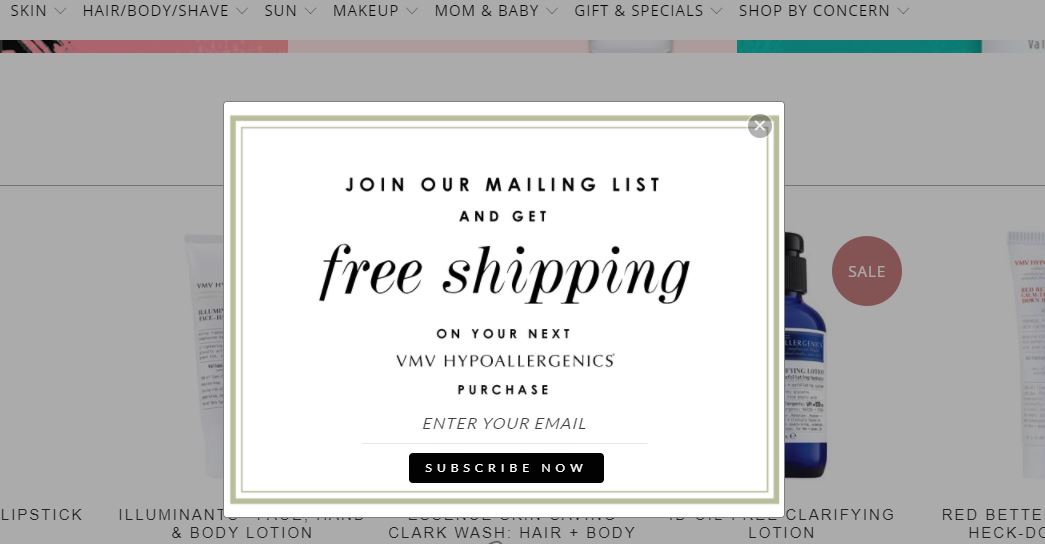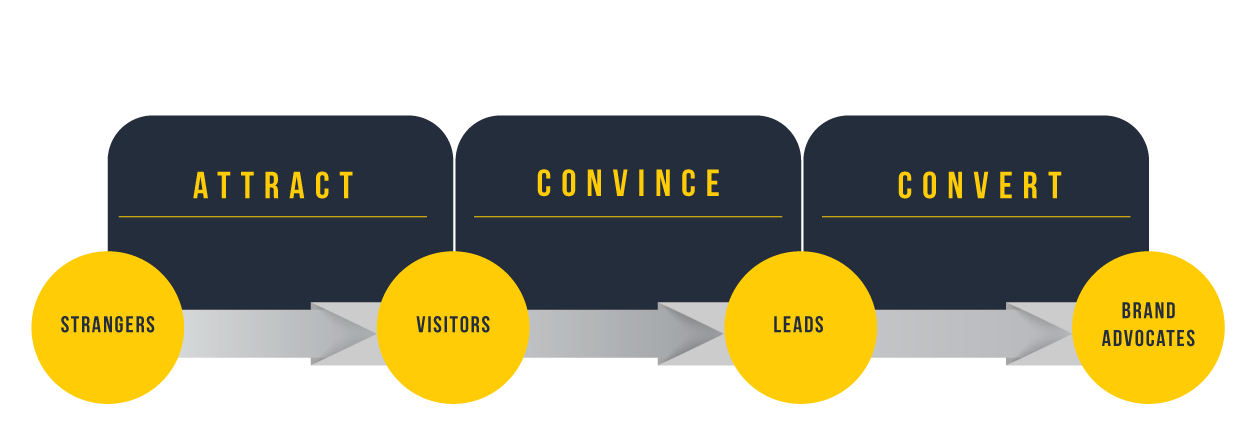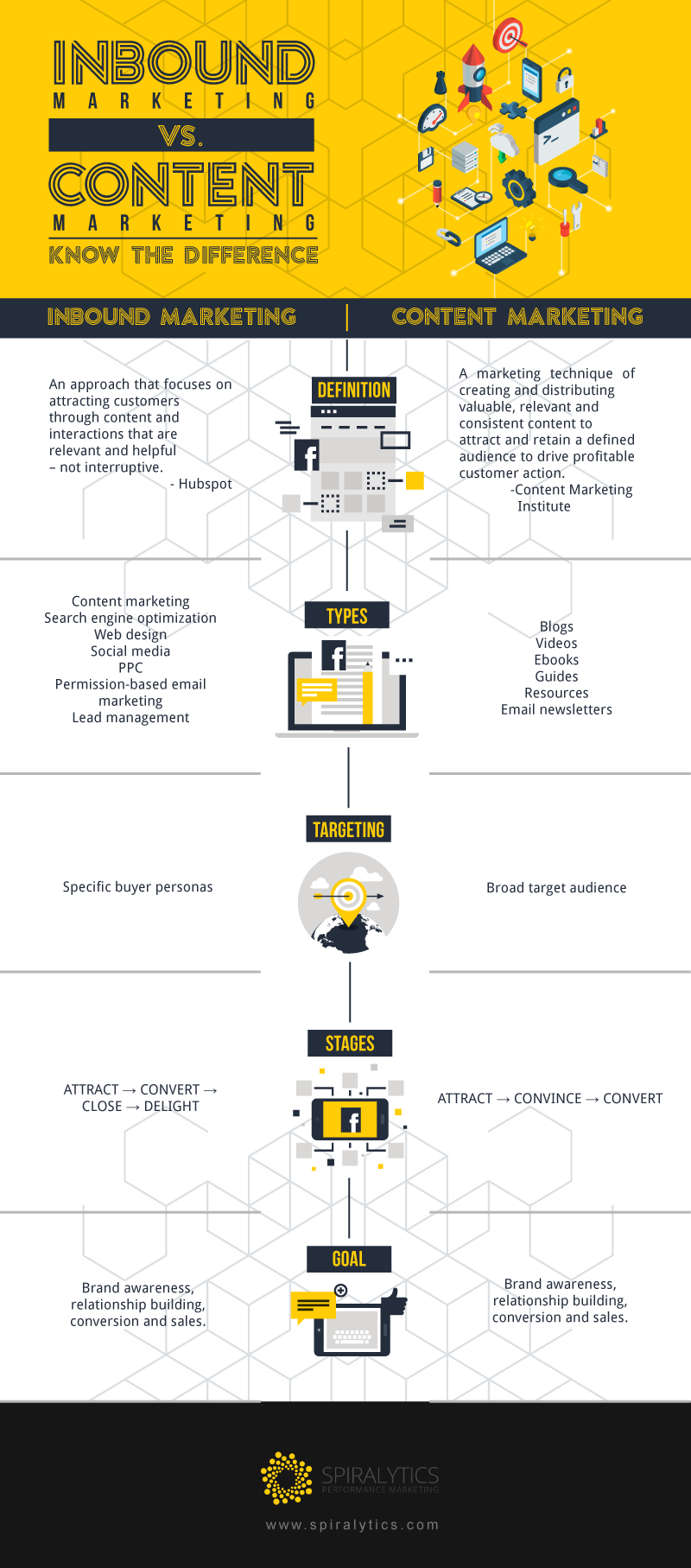Let’s compare the two marketing strategies.
Many people use the terms inbound marketing and content marketing interchangeably, including us marketers and sales professionals. I was guilty of it myself when I was just starting out in the industry until I figured out their actual functions and had a hands-on experience of the two strategies.
It’s hard to blame people though, as both share the same goal of attracting, engaging, and converting leads into customers to eventually grow sales and profits. So it’s easy to tell where the mix-up comes from. That being said, the two marketing strategies are different concepts, and you should be able to tell them apart, especially if you’re implementing them for your business.
So, how does inbound marketing differ from content marketing? Where do they overlap and what distinguishes each one? To answer those questions, let’s break down the details of each concept.
What is Inbound Marketing?
HubSpot defines inbound marketing as an approach that “focuses on attracting customers through content and interactions that are relevant and helpful – not interruptive.”
Inbound marketing is an approach that focuses on attracting customers through content and interactions that are relevant and helpful – not interruptive.
– HubSpot
Let’s put it this way: Instead of the traditional style of blasting cold emails and calling prospects over the phone to pitch your product or service, inbound marketing uses value adding to pull prospects towards your brand.
Customers don’t usually like to be disrupted with business promotions. Inbound marketing addresses this by considering the reality that customers are more likely to be accepting of a targeted offer or respond to a call to action when they make the decision themselves.
Inbound marketing makes it easier for customers to find you through social media, search engines, promotions, and other relevant content because you’re naturally providing answers that they’re looking for.

An excellent example of an inbound marketing effort is a pop-up targeting a repeat visitor.
Image Source: VMV HYPOALLERGENICS®
HubSpot also states that inbound marketing is a “holistic and integrated strategy” to attract prospects to you and nurture them until they are sales-ready. You might not be aware of it, but many tactics commonly utilized today are considered components of inbound marketing, including blogging, social media marketing, search engine optimization, web design, PPC advertising, permission-based email marketing, and much more.
But inbound marketing isn’t exclusive to online efforts alone. Producing engaging content both online and offline, attending industry events and conferences, and participating in public speaking engagements that help build thought leadership for your brand are also forms of inbound marketing.
If you haven’t gotten the grasp of what inbound marketing is yet, let me walk you through the four states of the inbound process – ATTRACT, CONVERT, CLOSE, and DELIGHT.
.png)
HubSpot categorized the four states of inbound methodology as follows: ATTRACT, CONVERT, CLOSE, and DELIGHT.
1st State: ATTRACT
Drawing the right users to your site. The “right users” are those with the most potential to become leads or future customers. Some of the best ways to attract users to your site are through blogging, SEO, and social media publishing.
2nd State: CONVERT
Attracted website visitors turn into leads by gathering their contact information. One of the typical tactics to get a customer’s email address is by offering valuable content that they can download like ebooks and whitepapers.
3rd State: CLOSE
Transforming leads into customers. Through email, customer relationship management (CRM) and other marketing tools, you can make sure you’re closing the right leads at the right time.
4th State: DELIGHT
Continuous engagement of visitors, leads, and existing customers. You keep your customers’ happiness and loyalty to you in check through surveys, smart call-to-actions, and much more.
What is Content Marketing?
There are a lot of definitions online about content marketing but here’s one from the Content Marketing Institute that I think sums it all up perfectly: “Content marketing is a marketing technique of creating and distributing valuable, relevant and consistent content to attract and retain a defined audience to drive profitable customer action.”
Read: Read the Beginner’s Guide to Content Marketing
Content marketing is a marketing technique of creating and distributing valuable, relevant and consistent content to attract and retain a defined audience to drive profitable customer action. – Content Marketing Institute
It centers on the creation of exceptional, highly-relevant and useful content and encompasses distribution across different channels, both online and offline. The blog posts, ebooks, infographics, how-to guides and videos you frequently see on websites and social media are just a few examples of the “content” that brands create, adding value to their target market’s lives and encourage the start of relationships with potential customers.

Infographics and other visual guides are all tools of a content marketing campaign.
Image Source: National Bookstore
For instance, a retail company selling clothing for men and women wants to build brand awareness, brand loyalty, and generate sales. This brand could utilize content marketing to create a variety of content about fashion and lifestyle (topics that their target market is searching for online). This move gives them an opportunity to put themselves in front of users who fit their ideal customer dimensions.
As I’ve mentioned earlier, more and more people these days dislike aggressive marketing schemes and ignore hard-sell sales pitches. That’s why content marketing has become a favored way to gradually build and nurture relationships with prospects. It’s an awesome strategy for building trust and creating awareness about your brand.

The content marketing process has three stages namely: ATTRACT, CONVINCE and CONVERT.
ATTRACT
Captivating the right audience. This stage brings the right people to your site. It begins in the creation of a well-thought out content marketing strategy. Determining your goals and target audience, listing down your distribution channels, and analyzing your metrics and optimization strategies are very critical to attracting the right audience.
Publish content that gives your readers value. It could be in the form of guides, infographics, and ebooks to name a few. After publishing, you distribute it across various channels such as social media and email newsletters to reach your target readers.
CONVINCE
Keeping your audience. This stage is where you persuade your audience to be an active member of your community. Ask users to sign up to your newsletter so you can engage with them on a regular basis using valuable content to build a relationship.
CONVERT
Driving the prospect towards a desired action. At this point, you’re moving your efforts to turning your readers and followers into qualified leads. When they sign up for your webinar, download an ebook that you produce, or fill out a form on your site, you’re a step closer towards turning them into customers.
What are the Similarities Between Inbound Marketing and Content Marketing?
Content is the lifeblood for both strategies.
Notice the similarities between the two? Well, they may have used different terminologies in each definition, but we cannot dismiss the fact that “content” is the central ingredient of both strategies. The two are just impossible without creation of valuable content.
Both are non-interruptive and practice the more customer-centric marketing approach.
Both inbound marketing and content marketing observe the more customer-centric marketing approach that considers customer needs and satisfaction above everything else. They are non-interruptive, and both depend on the slow but steady building of a relationship between a business and its target audience to generate leads and convert customers.
Between Inbound Marketing vs Content Marketing
Inbound marketing is a method of attracting and converting potential customers to a website through channels, like content, social media, and SEO. Content marketing, a subset of inbound marketing, specifically focuses on creating and distributing valuable, relevant content.
Specific buyer persona VS Broad target audience
Inbound marketing reaches out to specific buyer personas while content marketing focuses on the broad target audience.
Website building and conversion VS Content creation and distribution
Inbound marketing focuses on building a website and its content, targeted to encourage readers to perform an action such as inquire, buy a product, or complete a form. Meanwhile, content marketing just focuses on the specific methods of creation and distribution of content across multiple channels.
Inbound marketing involves other strategies not included in content marketing.
Inbound marketing covers other strategies that help with organic SEO; building, maintaining and optimizing your website; running ads; and monitoring of online reputation, which are not included in content marketing.

Is Content Marketing just part of Inbound Marketing?
Based on the results of The State of Inbound survey led by Hubspot, the majority of marketers consider content marketing as a subset of inbound marketing, and I couldn’t agree more. Personally, I think an effective content marketing campaign should incorporate other inbound marketing tactics to maximize results.
While content marketing centers on building relationships through valuable content, inbound marketing is the “bigger picture” that uses various concepts and approaches to inspire a customer to act in favor of your brand.
How to Maximize Your Inbound Marketing Strategy
Content marketing alone can’t guarantee success. For your digital marketing efforts to generate wins, you need to implement a full inbound marketing strategy — which is basically content marketing accompanied with these other efforts:
Search Engine Optimization (SEO)
The internet is every customer’s go-to place for recommendations and reviews when they are looking for products, services and brands, that’s why your inbound marketing strategy should be able to cater to these “searchers”. Needless to say, every search is an opportunity to build relationships with your target audience and influence their purchase decision.
Imagine the internet as an endless sea of content (which is sort of is). Your blogs have to be optimized for search engines to stand out and get discovered. Search Engine Optimization (SEO) is the practice of getting traffic from the “free,” “organic,” “editorial” or “natural” search results on search engines, as explained by Search Engine Land.
SEO is the practice of getting traffic from the “free,” “organic,” “editorial” or “natural” search results on search engines. – Search Engine Land
Every piece of content you create including pages in your website should be optimized. SEO not only helps your content rank better on SERPs (Search Engine Results Pages), but it also helps in analyzing keywords data and trends so you can create more compelling and link-worthy content for your prospects. Creating SEO-friendly content focused on your target keywords is a must in every inbound marketing strategy.
Read: 9 Essential SEO Strategies to Maintain Your SERP Position
Web Design
Web design is a highly valued element of inbound marketing as your website is the first thing that a potential customer sees when they search for your brand online. Studies show that 75% of consumers judge a business’ credibility based on their website design. Having a lousy web design will reflect poorly on your brand or worse, it could scare a potential customer away and send them straight into the arms of your competitor.
75% of consumers judge a business’ credibility based on their website design.
– Stanford Web Credibility Research
Every blog, ebook, video, infographic, webinar and podcast you have — all the content you create should have a prominent place on your website. Not only that, your site should take conversion optimization seriously.
As conversion is the primary metric monitored in inbound marketing, your website should have a clear call-to-action. Do not leave your visitors unsure of what the next steps for them are. Your web design should be able to tell precisely the “Step 2” for your prospective customers.
If you want to have great inbound marketing web design, follow these quick tips:
1. Make a plan
A high-converting web design considers what your prospects want at every stage of their buying journey to turn website visitors into leads. Part of your inbound marketing strategy should be plotting out the steps your potential customers might follow in your site — reading a blog, downloading an ebook on a related topic, requesting an assessment, etc — and turn readers into sales-ready leads.
2. Have a responsive design
People often use several devices when they go online and your website should be able to respond to the range of different screens available. This includes desktop, tablet and smartphones. Responsive design gives readers a better user experience.
3. Optimize your site for conversion
Your every page should give visitors a chance to become leads. Make it easy and convenient for your visitors to contact you, to learn more about your business, or to make a purchase through your calls-to-action, landing pages and forms.
Don’t forget about your blog! The right tactics can help turn it into a lead generating machine.
4. Add social sharing plugins
Through social sharing plugins, your visitors can easily share your website content directly to their social media accounts, widening the reach of your website to potential customers.
Social Media
Just like SEO and web design, social media is a critical aspect of inbound marketing. Besides potentially being the top driver of visitors to your website, social media shouldn’t be missing from your inbound marketing strategy for a number of reasons:
1. Social media is where you promote your content
Sharing your blogs to your social sites and encouraging your network to share your content with their connections do wonders for driving new and qualified visitors to your site.
2. Social media lets you engage with influencers
These influencers are experts in their fields and have large followings that include your ideal customers. Social media serves as your bridge to network with bloggers and brand ambassadors who can help promote your content through their social channels, blog, and other connections.
3. Social media helps you gather content ideas
Through discussion forums like Quora and Reddit, or even the more popular social media sites like Facebook, Twitter and LinkedIn, you can learn about what types of content people are sharing and talking about.
Social media monitoring tools provide you with data on what is being shared the most and what is resonating on social media. This can guide you to creating content that people genuinely want to read.
4. Monitoring social conversations is one of the best ways to get leads
People are talking about business issues on LinkedIn and about personal concerns on Facebook. People are dropping questions on Twitter, hoping that someone will reply with answers or suggestions. These natural “conversations” are sales opportunities. You need to be on social networks to be part of the conversation, and you need to be listening if you want to gain any insights.
Read: How to Leverage Social Media to Grow Your Business Exponentially
Pay-Per-Click Advertising
Pay-Per-Click (PPC) Advertising is also a part of inbound marketing. Although it’s not free and requires you to pay for placement, it reaches customers in a non-interruptive way when they researching about a purchase — the very essence of inbound marketing. If you want to drive dramatic increases in your website traffic, pay-per-click can provide you with an opportunity.
PPC Advertising is query-triggered like SEO. For instance, a user searches for “restaurant” on their mobile phone, they will eventually get a mobile PPC ad from your food service business. The ad will not interrupt the flow of what they’re doing and will provide information on what they are looking for.
Some quick tips to help your PPC campaign become a success:
1. Make your ad prospect-focused
Your ad should be focused on your customers and not at all about your company or product. Make your copy more prospect-focused to make the offer more relevant and attractive.
2. Use landing pages instead of homepages
Unlike a homepage which tends to be cluttered and multi-objective, a landing page fulfills one goal like getting registrants for your webinar, downloading an ebook or checklist, or getting sign ups for your website. Use landing pages to focus on a singular offer or campaign.
3. Apply personalized experience and micro-segmentation
For instance, if you want to target a specific company for your B2B business, you can start promoting content and educational sponsored updates to only the C-level executives at that organization. You can create blogs that are personal to their role, industry or company, and present it to them via social advertising.
Read our ebook: Step by Step Guide to Start an SEM Campaign Without Losing Money
Permission-based Email Marketing
Email marketing is an effective tactic for businesses of all industries as it helps in lead generation and customer retention efforts. But there’s one important word to remember before fully leveraging the power of email marketing: Permission.
It was Seth Godin who popularized the term “permission marketing” to describe the strategy of delivering anticipated, personalized and relevant messages for people who want to receive them.
Permission marketing is the privilege (not the right) of delivering anticipated, personal and relevant messages to people who actually want to get them. – Seth Godin
You’ve gotten a permission when your prospects allowed you to send them email campaigns, likely by willingly entering their email address in a subscribe form on your website.
Permission-based email marketing is necessary for inbound marketing as you’ll need your prospects’ permission to send messages to their emails. Sending unsolicited emails is unethical and will only land you into spam folder of your recipients.
When you ask for permission, you’re creating avenues to gain the trust of your prospects, which is key to nurturing your relationship with them. Honor the trust they’ve given you by not spamming their inbox and sending them only what they signed up for.
Download our ebook: A Guide to Smarter Content-Driven Email Marketing Strategy
Lead Management
Inbound marketing exists to turn prospects into customers. As leads enter at the top of your sales funnel, it is essential to manage these leads effectively.
Here are some quick pointers to employ better lead management strategies and help ensure the success of your inbound marketing campaign.
Lead scoring
Have a system that takes note of your prospect’s behaviors that are important to both your marketing and sales teams. Also define the point when a lead is “marketing qualified” so both your marketing and sales team can also clearly prioritize which leads should garner the most attention and follow up efforts.
Continuous engagement
Just because a lead downloaded your top of funnel offer but did not move into the middle of the funnel does not mean that you should forget about them entirely. Continue to present this lead with relevant content over time. A lead might not be sales-ready at the time of their initial conversion, but they could eventually get there, right?
Segmented lists
The data you’ve collected about your prospects is only useful if you can analyze and use them to create audience segments that will focus your marketing efforts and move your company forward.
Smart CTAs
So a prospect has downloaded your ebook. Help nurture your lead by presenting a different, middle of the funnel offer that will build off their previous engagement and continue to educate them on the topic. With Smart CTAs you can do just that.
Effective form strategy & smart forms
Use form fields to continue to gather pertinent information about your leads. If you already know a particular piece of information about them, instead of asking for it again, ask for the next important piece of information that will help you score, segment, or sell to that lead.
Takeaway
More than the argument on which is better between inbound marketing and content marketing, your companies’ focus should be on understanding what the two strategies can do for your business and customers.
There are some crucial tasks beyond the content marketing scope that could help your business succeed online — like technical SEO, web design and lead management — which are all elements of inbound marketing. Once you manage to get these all firing together, increasing your metrics and finding new customers will be a piece of cake.





